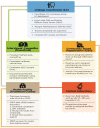Optimizing community linkage to care and antiretroviral therapy Initiation: Lessons from the Nigeria HIV/AIDS Indicator and Impact Survey (NAIIS) and their adaptation in Nigeria ART Surge
- PMID: 34543306
- PMCID: PMC8451986
- DOI: 10.1371/journal.pone.0257476
Optimizing community linkage to care and antiretroviral therapy Initiation: Lessons from the Nigeria HIV/AIDS Indicator and Impact Survey (NAIIS) and their adaptation in Nigeria ART Surge
Abstract
Background: Ineffective linkage to care (LTC) is a known challenge for community HIV testing. To overcome this challenge, a robust linkage to care strategy was adopted by the 2018 Nigeria HIV/AIDS Indicator and Impact Survey (NAIIS). The NAIIS linkage to care strategy was further adapted to improve Nigeria's programmatic efforts to achieve the 1st 90 as part of the Nigeria Antiretroviral Therapy (ART) Surge initiative, which also included targeted community testing. In this paper we provide an overview of the NAIIS LTC strategy and describe the impact of this strategy on both the NAIIS and the Surge initiatives.
Methods: The NAIIS collaborated with community-based organizations (CBOs) and deployed mobile health (mHealth) technology with real-time dashboards to manage and optimize community LTC for people living with HIV (PLHIV) diagnosed during the survey. In NAIIS, CBOs' role was to facilitate linkage of identified PLHIV in community to facility of their choice. For the ART Surge, we modified the NAIIS LTC strategy by empowering both CBOs and mobile community teams as responsible for not only active LTC but also for community testing, ART initiation, and retention in care.
Results: Of the 2,739 PLHIV 15 years and above identified in NAIIS, 1,975 (72.1%) were either unaware of their HIV-positive status (N = 1890) or were aware of their HIV-positive status but not receiving treatment (N = 85). Of these, 1,342 (67.9%) were linked to care, of which 952 (70.9%) were initiated on ART. Among 1,890 newly diagnosed PLHIV, 1,278 (67.6%) were linked to care, 33.7% self-linked and 66.3% were linked by CBOs. Among 85 known PLHIV not on treatment, 64 (75.3%) were linked; 32.8% self-linked and 67.2% were linked by a CBO. In the ART Surge, LTC and treatment initiation rates were 98% and 100%, respectively. Three-month retention for monthly treatment initiation cohorts improved from 76% to 90% over 6 months.
Conclusions: Active LTC strategies by local CBOs and mobile community teams improved LTC and ART initiation in the ART Surge initiative. The use of mHealth technology resulted in timely and accurate documentation of results in NAIIS. By deploying mHealth in addition to active LTC, CBOs and mobile community teams could effectively scale up ART with real-time documentation of client-level outcomes.
Conflict of interest statement
The authors have declared that no competing interests exist.
Figures


Similar articles
-
Ensuring Optimal Community HIV Testing Services in Nigeria Using an Enhanced Community Case-Finding Package (ECCP), October 2019-March 2020: Acceleration to HIV Epidemic Control.HIV AIDS (Auckl). 2021 Aug 25;13:839-850. doi: 10.2147/HIV.S316480. eCollection 2021. HIV AIDS (Auckl). 2021. PMID: 34471388 Free PMC article.
-
Expanding access to HIV services during the COVID-19 pandemic-Nigeria, 2020.AIDS Res Ther. 2021 Sep 19;18(1):62. doi: 10.1186/s12981-021-00385-5. AIDS Res Ther. 2021. PMID: 34538268 Free PMC article.
-
High rates of loss to follow-up during the first year of pre-antiretroviral therapy for HIV patients at sites providing pre-ART care in Nigeria, 2004-2012.PLoS One. 2017 Sep 1;12(9):e0183823. doi: 10.1371/journal.pone.0183823. eCollection 2017. PLoS One. 2017. PMID: 28863160 Free PMC article.
-
A Systematic Review of Linkage-to-Care and Antiretroviral Initiation Implementation Strategies in Low- and Middle-Income Countries Across Sub-Saharan Africa.AIDS Behav. 2022 Jul;26(7):2123-2134. doi: 10.1007/s10461-021-03558-5. Epub 2022 Jan 28. AIDS Behav. 2022. PMID: 35088176 Free PMC article.
-
Compliance with reporting standards in Mobile App interventions for ART Adherence among PLHIV.AIDS Res Ther. 2024 Nov 22;21(1):85. doi: 10.1186/s12981-024-00666-9. AIDS Res Ther. 2024. PMID: 39578861 Free PMC article. Review.
Cited by
-
Principal component analysis of the Serological response to Plasmodium Falciparum using a Multiplex bead-based assay in Nigeria.Sci Rep. 2024 Dec 28;14(1):30658. doi: 10.1038/s41598-024-74236-4. Sci Rep. 2024. PMID: 39730380 Free PMC article.
-
Using testing history to estimate HIV incidence in mothers living in resource-limited settings: Maximizing efficiency of a community health survey in Mozambique.PLOS Glob Public Health. 2023 May 31;3(5):e0001628. doi: 10.1371/journal.pgph.0001628. eCollection 2023. PLOS Glob Public Health. 2023. PMID: 37256868 Free PMC article.
-
Analyses of Kaposi Sarcoma trends among adults establishing initial outpatient HIV care in Nigeria: 2006-2017.Infect Agent Cancer. 2022 Mar 21;17(1):10. doi: 10.1186/s13027-022-00424-4. Infect Agent Cancer. 2022. PMID: 35313941 Free PMC article.
-
Sub-optimal satisfaction of people living with HIV and AIDS regarding their care in Burkina Faso, West Africa.J Public Health Afr. 2023 Oct 1;14(9):2432. doi: 10.4081/jphia.2023.2432. eCollection 2023 Oct 1. J Public Health Afr. 2023. PMID: 37908387 Free PMC article.
-
Ensuring equitable access to quality HIV care for affected populations in complex sociocultural settings: Lessons from Nigeria.PLoS One. 2025 May 14;20(5):e0319807. doi: 10.1371/journal.pone.0319807. eCollection 2025. PLoS One. 2025. PMID: 40367072 Free PMC article.
References
-
- Federal Ministry of Health, Nigeria. Nigeria HIV/AIDS Indicator and Impact Survey (NAIIS) 2018: Technical Report. Abuja, Nigeria. October 2019.
-
- Marsh K., Eaton J. W., Mahy M., Sabin K., Autenrieth C. S., Wanyeki I., et al.. Global, regional and country-level 90-90-90 estimates for 2018: assessing progress towards the 2020 target. AIDS (London, England). 2019, 33Suppl 3(Suppl 3), S213–S226. doi: 10.1097/QAD.0000000000002355 - DOI - PMC - PubMed
-
- Onyeonoro U. U., Ogah O. S., Ukegbu A. U., Chukwuonye I. I., Madukwe O. O., & Moses A. O. Urban–Rural Differences in Health-Care-Seeking Pattern of Residents of Abia State, Nigeria, and the Implication in the Control of NCDs. Health Services Insights. 2016. doi: 10.4137/HSI.S31865 - DOI - PMC - PubMed
-
- Differentiated service delivery for HIV: a decision framework for HIV testing services. Available from: www.differentiatedservicedelivery.org.
Publication types
MeSH terms
Substances
LinkOut - more resources
Full Text Sources
Medical

